Controlled modulation of the pharmacokinetics and biodistribution of aptamer therapeutics
a technology of aptamer and aptamer molecule, which is applied in the field of nucleic acid therapeutics, can solve the problems of limiting the availability of some biologics, scalability and cost, and the difficulty of eliciting antibodies to aptamer, and achieves the effect of increasing the clearance rate of plasma aptamer
- Summary
- Abstract
- Description
- Claims
- Application Information
AI Technical Summary
Benefits of technology
Problems solved by technology
Method used
Image
Examples
example 1
Pharmacokinetic and Biodistribution Modulation of Aptamers Via Conjugation
[0196] Aptamer synthesis. The nucleotide sequence and predicted secondary structure of the parent oligonucleotide for the TGFb aptamer ARC83(SEQ ID NO 5) is shown in FIG. 2 (Pagratis, et al. (2002), High affinity TGFb nucleic acid ligands and inhibitors. USA, Gilead Sciences, Inc). Syntheses of ARC83 and the corresponding fully 2′-O-Me modified variant, ARC159 (SEQ ID NO 15), were performed using standard solid-phase phosphoramidite chemistry, followed by ion-exchange high pressure liquid chromatography (HPLC) or polyacrylamide gel electrophoresis (PAGE) purification. The ARC83 aptamer was synthesized by Dharmacon, Inc., Lafayette, Colo.
Synthesis of Aptamer Conjugates.
[0197] ARC83 NH2— mGGmGmGfUfUmAfLfUAfCAmGmAmGfUfCfUmGfUmAfUmAmGfCfUmGfUAfCfCfC-3T (SEQ ID NO 5) was synthesized using standard procedures. The terminal amine function was attached to the aptamer nucleotide sequence using a six carbon linker a...
example 2
Hybridization-Based Dual-Capture Assay for Aptamer Quantitation
[0206] To facilitate in vivo studies, a hybridization-based dual probe capture assay with enzyme-linked fluorescent readout for monitoring the concentration of intact, undegraded aptamer in biological samples was developed (shown schematically in FIG. 3A). Generally, the assay used a capture probe attached to a solid support (e.g., a 96-well plate bottom), and a FAM-labeled detection probe. When the aptamer-containing sample and probes are combined in the assay well, the pre-immobilized capture probe forms a hybrid with the 5′ end of the oligonucleotide (e.g., aptamer) to be detected and the pre-annealed detection probe formed a hybrid with the 3′ end. Following extensive washing to remove free probe molecules, an anti-FAM-HRP conjugate was combined to generate a fluorescent signal proportional to the concentration of retained probe-aptamer complex.
[0207] This hybridization-based dual-capture pseudo-ELISA (FIG. 3A) was...
example 3
Detection of Intact Aptamers From Biological Samples
[0212] The primary analytical method used to measure the concentration of intact, nonradioactive aptamers in biological samples, e.g., plasma, tissue and urine, was the hybridization-based dual-capture pseudo-ELISA described above (See FIG. 3A). Additional bioanalytical methods used included capillary gel electrophoresis (CGE) and MALDI-TOF. For CGE analysis, samples spiked with 50 pmole of an oligonucleotide (T20) internal standard were incubated in buffer (60 mM Tris-Cl, pH 8.0, 100 mM EDTA, 0.5% SDS) containing proteinase K at 500 μg / ml at 65° C. for 4 hrs. Digests were extracted twice with phenol / chloroform, and then precipitated with ammonium acetate. CGE (Beckman P / ACE 5010) was performed at 25° C. using 10% polyacrylamide gel-filled capillaries (20 cm) and an applied voltage of 550 V / cm. Elution of oligonucleotides from the gel was monitored using UV detection at 260 nm. Under these conditions, resolution of aptamers from c...
PUM
| Property | Measurement | Unit |
|---|---|---|
| molecular weight | aaaaa | aaaaa |
| molecular weight | aaaaa | aaaaa |
| molecular weight | aaaaa | aaaaa |
Abstract
Description
Claims
Application Information
 Login to View More
Login to View More - R&D
- Intellectual Property
- Life Sciences
- Materials
- Tech Scout
- Unparalleled Data Quality
- Higher Quality Content
- 60% Fewer Hallucinations
Browse by: Latest US Patents, China's latest patents, Technical Efficacy Thesaurus, Application Domain, Technology Topic, Popular Technical Reports.
© 2025 PatSnap. All rights reserved.Legal|Privacy policy|Modern Slavery Act Transparency Statement|Sitemap|About US| Contact US: help@patsnap.com



